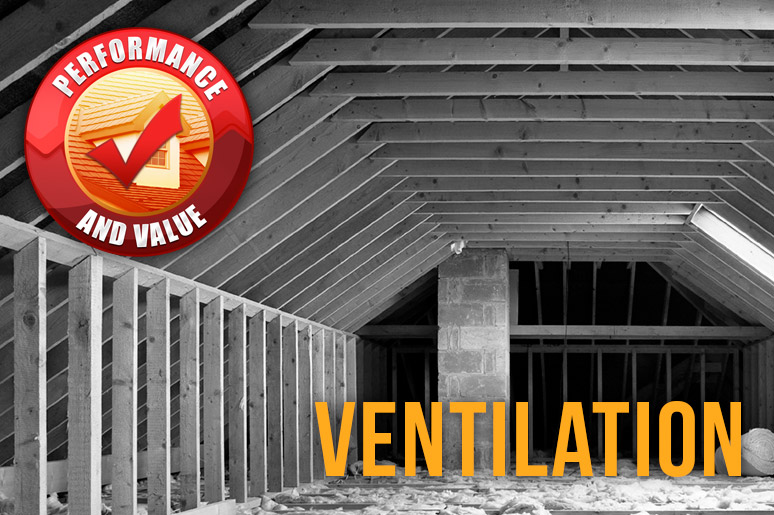Performance and Value of Your Home’s Roof: Ventilation
January 20, 2017 | Filed under: Newsletter Articles,Research

The fact is, for most homes, the roof provides greater protection than any other part of the house, and it’s also a major aesthetic feature of the home. So, it makes sense to ensure that your roof is looking and performing as well as possible. Let’s dig into the subject of Ventilation and how it impacts roof performance.
We often get asked whether metal roofs bring special ventilation needs or condensation concerns when installing on homes. The general answer to that is “no” but, as with most things, there is an additional story to dig into.
Unless a home has been built specifically in a manner that does not require attic ventilation (such as a conditioned space or hot attic, or perhaps insulated panel construction), there are three reasons why good ventilation is important with ANY home – regardless of the roof covering.
3 Reasons Good Ventilation is Important For Any Home
- Energy Efficiency. Ventilation is used during the summer to vent heat out of the attic, reducing air conditioning costs. For many years, building science experts were focused on reflectivity as a way to keep heat out of the attic. While reflective or “cool roofs” are still a good idea, tests have shown that good ventilation which quickly removes any gained heat is equally if not more effective at improving home energy efficiency.
- Condensation. A great deal of moisture is generated inside of a home’s living space. It is generated primarily by laundry, showers and bathing, houseplants, cooking, and ventless stoves. That moisture, originating in the living space of the home, migrates upward and if a 100% reliable vapor barrier is not in place behind the home’s ceilings, it ends up in the attic. Once it’s in the attic, if that warm, moisture-laden air reaches a cool surface, it condenses. The resulting condensation can create a very unhealthy environment prone to support mold, mildew, and other biological growth. A well-vented attic also helps to keep your attic’s insulation dry which increases its effectiveness. Damp insulation loses considerable R-Value.
- Ice Dams. For homes in northern climates, good attic ventilation can help minimize the potential for winter ice dams. Ice dams occur when warm air from the living space reaches the roof deck and causes the snow to melt. The melted snow then runs down the roof and refreezes over the home’s cold overhangs, creating damaging and dangerous ice dams which can force melted snow into the home. Proper attic ventilation ideally keeps the attic the same as outside temperatures, avoiding any chance of melting snow and ice dams.
With traditional roofing choices, there is a fourth reason why attic ventilation can be helpful. Good attic ventilation can help increase shingle life. By keeping rooftop temperatures a bit cooler, shingle life can be preserved. This benefit does not really have an impact on roofing materials like metal, tile, and slate which are unaffected by high temperatures.
So, how do you achieve good attic ventilation?
Well, it requires both intake and exhaust vents. Intake vents are at the bottom of the roof, often in the home’s overhangs. Exhaust vents are typically at or near the ridge or peak of the roof. You want to have ventilation that creates total continuous air exchanges in the attic. Outside air flows in at the bottom of the roof, travels along the underside of the roof deck, and then carries heat and moisture from the attic, out of the attic space through the exhaust vents. A great deal of attic ventilation information is available on Airvent’s website.
When evaluating your attic’s ventilation, it is important to check and make sure that the soffit intake vents are not blocked by insulation. Blockages can happen over time when insulation is added to a home. Additionally, if you go the route of a ridge vent as your exhaust vent, any other exhaust vents including gable vents must be removed or blocked off. Otherwise, they will begin to act as intake vents and feed air to the ridge vent. In an attic where the air is moving properly, you will be able to observe air movement using a smoke pen or a small piece of light tissue paper.
Ideally, you want to have a balance between your intake and exhaust vents. You want equal amounts of intake and exhaust vents. If the amounts cannot be perfectly balanced then, if anything, you want slightly more intake vent than exhaust vent. This creates a pressurized system. If on the other hand, you have more exhaust vent than intake vent, you can start to bring air and weather in through the exhaust vents on the roof – not a good thing.
So, how much ventilation do you need? In most areas, building codes call for 1 square foot of ventilation per 150 square feet of attic floor space. As described above, the 1 square foot should be divided equally between intake and exhaust. If your home’s roof has a very steep pitch, and thus greater attic volume, the suggested amount of ventilation should be increased by about 20%. In certain extreme northern climates, if the home has a qualifying vapor barrier behind its ceilings, ventilation can be reduced by code to as little as 1 square foot per 300 square feet of attic floor space. Our general advice, though, is that more ventilation is better than less.
Ventilation product manufacturers will be able to tell you the amount of ventilation offered by their products. This is often called the net free airflow.
Keep in mind: some structures have been designed and built to not require attic ventilation. The building codes do not address this construction very well, but usually, local code officials are understanding of the different requirements necessitated based upon exact construction methods.
Again, a metal roof typically does not increase nor decrease the need for ventilation. Ventilation that meets code requirements is adequate for any type of roofing material, including metal. We do need to mention, though, one very rare scenario we have seen just a couple of times over our 35+ years. For existing homes in condensation-prone climates with ventilation that does not come anywhere close to meeting code standards, a metal roof can become the straw that breaks the camel’s back by decreasing the roof deck temperature just enough that dewpoint is reached in the attic, causing condensation to occur where it has not occurred before. In rare situations like this, an experienced contractor can help find a suitable solution. If you think your home might be borderline in having condensation and moisture control issues, be sure to discuss that with your contractor before starting any roofing project.
We hope that this information is helpful. If you have ventilation or roofing questions, feel free to email them to our own guru, Todd Miller, at todd@asktoddmiller.com. And of course, you can always visit us on the web at classicroof.com.
A Free, Helpful Tool
Additionally, if you’re considering a new roof for your home, please consider using our helpful and free online Roofing Needs Profiler which asks you a few questions and then gives you a personalized analysis and summary of your roofing needs including what type of roof may work best for you and your home.
